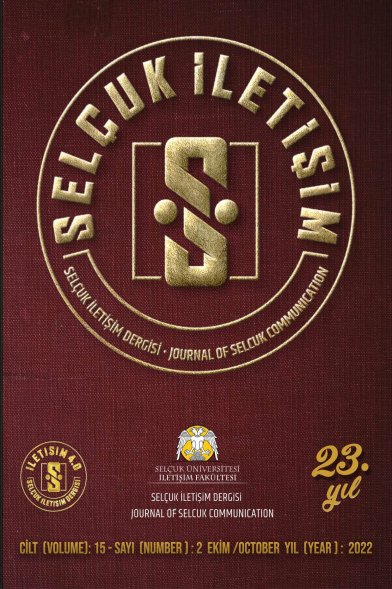KUZEYDOĞU ANADOLU BÖLGESİ’NDEKİ 0-8 YAŞ GRUBU ÇOCUKLARIN İNTERNET KULLANIMI VE BU KAPSAMDA EBEVEYN ARABULUCULUĞU: NİTEL BİR ARAŞTIRMA
A QUALITATIVE STUDY ON 0-8 YEAR OLD CHILDREN’S INTERNET USE AND THEIR PARENTS’ MEDIATION IN NORTHEAST ANATOLIA REGION
___
- Altay F B and Güre A (2012) Okulöncesi Kuruma (Devlet-Özel) Devam Eden Çocukların Sosyal Yeterlik ve Olumlu Sosyal Davranışları İle Annelerinin Ebeveynlik Stilleri Arasındaki İlişkiler, Kuram ve Uygulamada Eğitim Bilimleri, 12(4), 2699-2718.
- ATKINSON (2011) Early Childhood Education Report, http://www.oise. utoronto.ca/atkinson/About_Us/What_We_Do/Early_Childhood_Education_Rep ort/index.html , erişim tarihi: 14.04.2018
- Brown A (2011) Media Use by Children Younger Than 2 years, Pediatrics, 128(5), 1040-5.
- Chaudron S (2015) Young Children (0-8) and Digital Technology: A Qualitative Explaratory Study Across Seven Countries, Joint Research Centre Science and Policy Reports, http://publications.jrc.ec.europa.eu/repository/handle/JRC93239, erişim tarihi: 14.04.2018
- Common Sense Media (2011) Zero to Eight: Children’s Media Use in America, https://www.commonsensemedia.org/research/zero-to-eight-childrens-mediause-in-america, erişim tarihi: 14.04.2018
- Eastin M, Greenberg B S and Hofschire L (2006) Parenting the Internet, Journal of Communication, 56, 486- 504.
- Green L and Holloway D (2014) 0-8: Very Young Children and the Domestication of Touchscreen Technologies in Australia, http://www.anzca.net /documents /2014- conf-papers/748-anzca14-green-holloway.html, erişim tarihi: 14.04.2018
- Grimes S M and Fields D A (2012) Kids Online: A New Research Agenda for Understanding Social Networking Forums, http://www.joanganzcooneycenter. org/publication/kids-online-a-new-researchagenda-for-understanding-social-net working-forums/, erişim tarihi: 14.04.2018
- Holloway D, Green L and Livingstone S (2013) Zero to Eight, Young children and Their İnternet Use, LSE, EU Kids Online, eprints.lse.ac.uk/52630/1/Zero_t o_eight.pdf, erişim tarihi: 14.04.2018
- Holloway J D, Green L R and Brady D J (2013) 0-8: Young Children’s Internet Use, http://www.anzca.net/documents/2013-conf-papers/705-anzca-2013-hollo way-green-and-brady-1.html, erişim tarihi: 14.04.2018
- Kaşıkçı D N, Çağıltay K, Karakuş T, Kurşun E ve Ogan C (2014) Türkiye ve Avrupa’daki Çocukların İnternet Alışkanlıkları ve Güvenli İnternet Kullanımı, Eğitim ve Bilim, 39(171), 230-243.
- Lauricella A R, Wartella E and Rideout V J (2015) Young Children’s Screen Time: The Complex Role of Parent and Child Factors, Journal of Applied Developmental Pyschology, 36, 11-17.
- Livingstone S and Helsper E (2010) Balancing Opportunities and Risks in Teenagers’ Use of the INTERNET: The Role of Online Skills and the Internet Selfefficacy, New Media&Society, 12(2), 309- 329.
- Livingstone S, Haddon L, Görzig A and Ólafsson K (2011) Risks and safety on the internet: The perspective of European children, Full Findings, LSE, EU Kids Online,http://www.lse.ac.uk/media%40lse/research/EUKidsOnline/EU%20Kids% 20II%20(2009-11)/EUKidsOnlineIIReports/D4FullFindings.pdf, erişim tarihi: 14.04.2018
- Livingstone S, Mascheroni G and Staksrud E (2017) European Research on Children’s Internet Use: Assessing the Past and Anticipating the Future, New Media&Society, 20(3), 1103-1122.
- Marsh J (2014) Young Children’s Online Practices: Past, Present and Future, http://www.academia.edu/9799081/Young_Childrens_Online_Practices_Past_Pre sent_and_Future, erişim tarihi: 14.04.2018
- Marsh J, Brooks G, Hughes J, Ritchie L, Robert, S and Wright K (2005) Digital beginnings: Young Children’s Use of Popular Culture, Media and New Technologies, www.dcmp.org/caai/nadh177.pdf, erişim tarihi: 14.04.2018
- Nathanson A (2001) Mediation of Children’s Television Viewing: Working Toward Conceptual Clarity and Common Understanding, Annals of the International Communication Association, 25(1), 115-151.
- Ólafsson K, Livingstone S and Haddon L (2014) Children’s Use of Online Technologies in Europe, A review of the European evidence base, LSE, EU Kids Online, http://eprints.lse.ac.uk/50228/, erişim tarihi: 14.04.2018
- Sigman A (2012) Time For a View on Screen Time, BMJ Journal, 97, 935-942.
- Strasburger V C (2013) Children, Adolescents, and the Media, Pediatrics,132, 958–961.
- Valcke M, Bonte B, Wever B and Rots I (2010) Internet Parenting Styles and the Impact on Internet Use of Primary School Children, Computers& Education, 55, 454-464.
- Vandewater E A, Rideout V J, Wartella E A, Huang X, Lee J H and Shim M (2007) Digital Childhood: Electronic Media and Technology Use Among Infants, Toddlers, and Preschoolers, Pediatrics, 119(5), 1006-1015.
- Yayın Aralığı: 2
- Başlangıç: 1999
- Yayıncı: Selçuk Üniversitesi İletişim Fakültesi
ÜNİVERSİTE ÖĞRENCİLERİNİN KÜLTÜRLERARASI DUYARLILIK DÜZEYİ: SELÇUK ÜNİVERSİTESİ ÖRNEĞİ
KAMU SPOTLARININ ETKİLİLİĞİ ÜZERİNE BİR ARAŞTIRMA
Sevinç GÜLSEÇEN, Mehmet BÜTÜN, Emre AKADAL, Murat SELÇUK
Özlem DUĞAN, Bayram Oğuz AYDIN
Levent Ceylan, Özge Baruönü Latif, Müge Örs
Popülerleşme Sürecindeki Altkültür Temsilcilerinin Yaşadığı Çatışmalar: Joker Örneği
